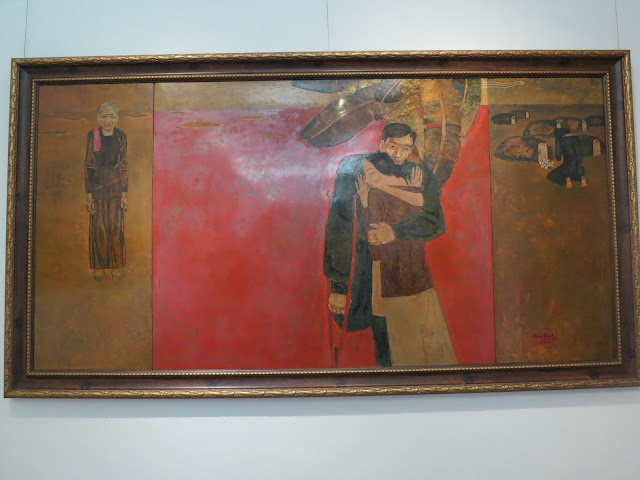From Siem Reap, we headed back to Vietnam and the last stop of our
trip: Ho Chi Minh City.
Some (benevolent dictator of) fun facts about Ho Chi Minh City: HCMC is Vietnam’s largest city, home to
approximately 8 to 10 million people. HCMC
was known as Saigon from the late 1800s to 1976, when its name was changed to
honor Ho Chi Minh. Ho Chi Minh led the independence movement and established the Communist-ruled Democratic Republic of Vietnam in
1945.
After the Vietnam war, Saigon, the former capital of the Republic of
Vietnam, was renamed Ho Chi Minh City. HCMC
is still commonly referred to as Saigon today.
The highlight of HCMC was definitely Sophie’s Art Tour, which was essentially an art history
lesson and field trip, broken in to 4 chapters:
French colonization: Vietnam's independence was gradually eroded
by France in a series of military conquests between 1859 and 1885. In 1862, the southern third of the country
became the French colony of Cochinchina. By 1884, the entire country had come
under French rule and was formally integrated into the union of French
Indochina in 1887. The French imposed
significant political and cultural changes on Vietnamese society, including
Roman Catholicism and a Western-style system of modern education. French influences are still abundant today, however. #coffee #banhmi #gerarddepardieu
For this part of the lesson, we went to view pieces from a private collection and we were not allowed to take pictures, but here's a picture of the outside. Duc Minh is the owner of the collection. Today, the museum is run by his grandson.
The most prized piece in the collection is pictured below (which I found based on a Google image search). It is called "Young Girl By Lilies" and is known as the "Mona Lisa of Vietnam." To Ngoc Van was the artist. This painting was especially scandalous when it was exhibited due to the fitted nature of the girl's clothing. #bowchickabowwow
Indochine Wars: The First
Indochina War (or the French War) was fought between 1946 and 1954 and sought
independence for Vietnam from France.
The French were defeated in 1954 at the Battle of Dien Bien Phu. Vietnam was then split into 2 regions at the
17th parallel, Communist North Vietnam, led by Ho Chi Minh, and
South Vietnam, led by Emperor Bao Dai.
The Second Indochina War (also the Vietnam War) was fought between 1955
and 1975 and sought to prevent the Communist takeover of South Vietnam by the north. The war ended with the fall of Saigon in
April 1975 as the North Vietnamese Army entered the city and overcame all
resistance.
We visited Lotus for this part of the lesson, which is a museum/store displaying old propaganda posters. I personally enjoyed this part--not necessarily for the messages, but I think the colors and simplicity of the posters are appealing. #artisticallyspeaking
More livestock, more manure
Is this Nixon's goal in Vietnam?
Leninism, which is the most righteous, the most reliable and the most revelutionary, said Uncle Ho
(Commemorating Lenin's 100th birthday, Lenin is the sun,Ho Chi Minh is to the left)
Who will win? Who will win the world's support?
Cling on to the sea for production and ready to fight
Develop poultry production
Doi Moi (Renovation): In the
aftermath of the war, the government embarked on a mass campaign of
collectivization of farms and factories.
This caused economic chaos and resulted in triple-digit inflation. In the late 1970s and early 1980s, millions
of people fled the country. Doi Moi were
economic reforms initiated in Vietnam in 1986 with the goal of creating a
"socialist-oriented market economy,” described as a multi-sectoral market
economy oriented towards the eventual and long-term development of socialism,
where the state plays a decisive role in directing economic development.
For this part of the lesson, we visited the Ho Chi Minh City Museum of Fine Arts Museum, which is located in a converted mansion, built in the 1920s by one of the wealthiest men in Saigon at the time. Did I mention that the museum is haunted by the daughter of this man? She is said to have died of leprosy, locked away in one of the bedrooms. Maddened by isolation, she screamed helplessly from her room. #wow
Drawing of one of the underground tunnels of the Ho Chi Minh Trail (logistical system that carried supplies from North Vietnam to the Viet Cong and North Vietnamese Army in South Vietnam)
Lacquer painting, created using multiple layers of tree resin, color, and eggshells #yesyoureadthatright
Close up of the painting above; their skin is made of eggshell! #forreal #nojoke #cool
Strong and healthy. #smellslikepropaganda
Strong, healthy, with a sickle. #smellslikemorepropaganda
Today: The younger generation of Vietnamese artists have become very active in involving different forms of arts, such as installation, performance and video art. For example, San Art is an artist-initiated, non-profit contemporary art organization dedicated to promoting, facilitating and showcasing contemporary art. San Art’s mission is to empower emerging artists in Vietnam and South East Asia by nurturing talent, fostering innovation and providing a forum for collaboration.
Sadness and grief after the war. This painting was painted fairly recently, as immediately after the war and for a period thereafter, grieving was to be done in private.
Abstract art by Vietnamese artists did not become popular until recently.
Well folks, that's all I've got! I'm back home now! #callme #youhavethenumber #vietnamwasawesome # tripofalifetime #butsfismyfavorite #home

















No comments:
Post a Comment